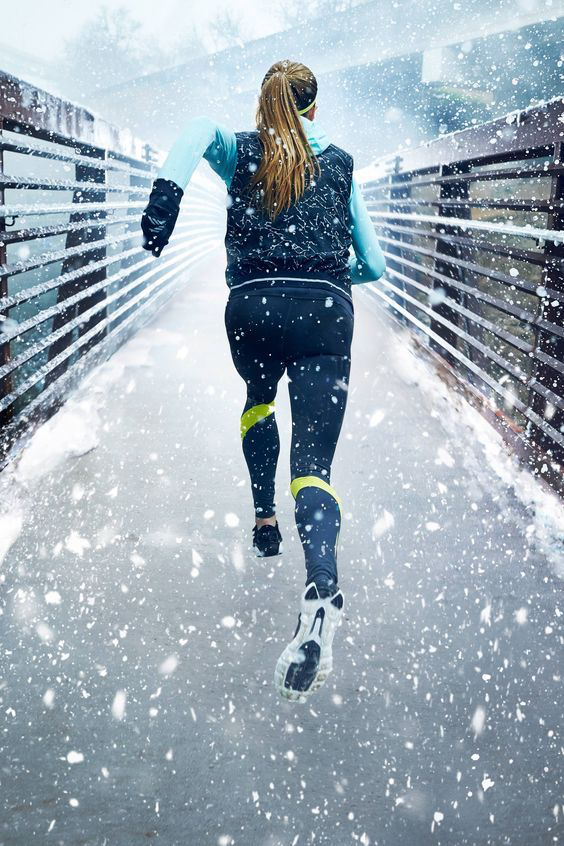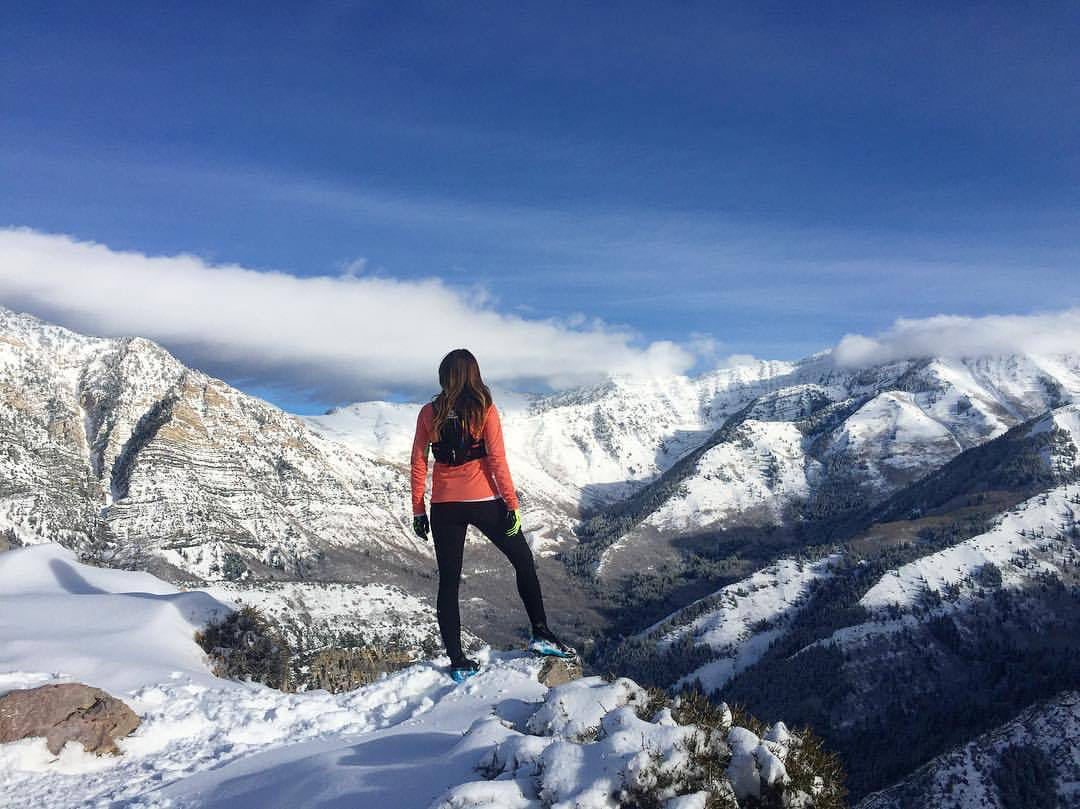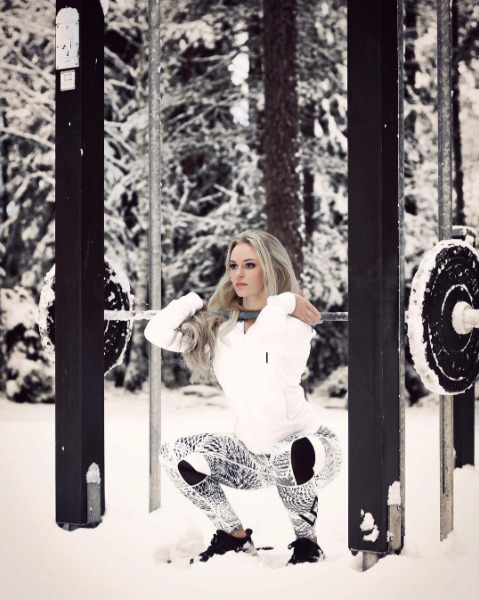
On a recent Saturday, I grabbed my towel and headed to the beach for a brisk November swim. I had a full wetsuit on, borrowed from a friend, and only stayed in for a few strokes, but the experience took my breath away—in a good way. My body had never felt so invigorated and energized, the effects of which lingered for hours and contributed to a euphoric glow well-known to open-water enthusiasts. My next thought: Where can I buy a wetsuit? Because I want to do this again.
As winter descends and access to gyms and fitness studios remains limited due to COVID-19 restrictions, many of us are shifting our workouts outside and into the fresh, bone-chilling air. It can admittedly feel punishing, but training in winter can be extremely beneficial, physically and mentally. Studies show that exercising in cold weather can increase the body’s metabolism and fat-burning ability, and getting into nature at any point in the year lowers risk for depression and ups your intake of immune-boosting vitamin D. Meanwhile, pro athletes who train outside year-round (eagerly!) anticipate the first frost as a chance to mix up their routines, work different muscle groups, and develop mental stamina. (An icy morning run is, as Bend, Oregon–based triathlete Linsey Corbin puts it, “character building.”) Personally, I find that pushing myself in gritty, even nasty, conditions makes me feel alive—it’s a much-needed jolt after so many months of being cooped up inside, when the days blur and mental numbness starts to seem normal.
Here, seven elite athletes share tips for tackling cold-weather workouts for a stronger mind and body.
Pick your sport and pre-train first
Go for an activity you genuinely enjoy—be it skiing, cycling, or running—which makes heading into the deep chill that much easier. If you’re new to a sport, tone key muscles ahead of time to avoid injury. For surfing, for example, Santa Cruz, California–based Chelsea Woody, cofounder of Textured Waves, recommends strengthening your core at home first. “Burpees are a great way to emulate the popping-up motion on your board,” she says. Or hop on an Indo Board to work on balance and stability. For cross-country skiing, try running with the poles so you can get used to the motion, says Kikkan Randall, an Olympic cross-country skier based in British Columbia, Canada.
Get the right gear
About 90% of exercising comfortably outside comes down to dressing properly. Go for technical, sweat-wicking fabrics, like antibacterial Smar wool, for your base layer. (Avoid cotton, since it holds moisture next to your skin like a cold sponge.) Then you’ll want an insulating layer, such as a performance vest that lets your arms move freely. That might be enough, depending on your activity level—a high-intensity run, for example, raises your body temperature more than a moderate hike—or finish with an outer shell that repels rain and snow. Lea Davison, a Sunderland, Vermont–based Olympic cyclist who is an ambassador for L.L.Bean, recommends one that’s windproof on the front but has panels at the back to release air and sweat. (Her pick: the Cresta Stretch Rain Jacket.) For warmth in the water, Woody wears Feral’s Hooded 543mm Japanese neoprene wetsuit, which is the “warmest and coziest I have found,” she says.

The bulk of body heat is stored in your core, where blood flow is concentrated, which leaves your extremities vulnerable to cold. “Heat regulation is all about your head and hands,” says Corbin, who wears running mittens, headbands, and hats by Saucony, one of her brand sponsors. Pulling a neck warmer up over your nose shields you and warms the air you exhale and breathe in—like a natural humidifier. Megan White, the New York–based founder of All Women’s Tri Team and five-time Ironman finisher, finds that “good socks are essential” and swears by Swiftwick’s Pursuit Four Ultralight. For comfort and traction, Davison wears cycling shoe covers, such as Garneau’s Thermax II, and switches to studded bike tires. Rebecca Mehra, a Bend, Oregon–based professional middle-distance runner, straps Yaktrax cleats over the soles of her sneakers for safer snow workouts. “You can also put bolts on the bottom of shoes for grip—sometimes local running stores will do it for you,” she says.
Fact: Muscles contract in cold weather, making them stiffer and less flexible. That’s why a dynamic warm-up—with active stretching movements—is so important. Mehra goes through a quick circuit of quad stretches and knee pulls, front and side lunges, and circles with her arms and shoulder and hips. Randall finds it helpful to loosen up with Addaday’s BioZoom pulsating massage device. “I spend 10 to 15 minutes on the major muscles groups—when I get on my skis, my muscles are awake and relaxed,” she says.
Pace yourself and adjust to the conditions
Simply getting outside and moving can be a decent workout at first. To stay motivated, try setting goals and challenges for yourself. (The running and cycling app Strava lets you track your progress, take part in virtual races, and follow other athletes.) Corbin, for her part, focuses on strength and aerobic endurance rather than speed in winter. “On the bike, this means holding good form while riding in a bigger gear at a lower cadence,” she says. “When running, I’ll do hills and trail runs, which require you to change your gait and have agility on the snow.” With cross-country skiing, try not to burn through your energy early, says Randall. “Most people start out too fast. It’s better to hold back so you can warm up and kick into gear as you go. The trick is being soft in the ankles and floating in that position. It takes five to six sessions until you feel your body adapt, and that’s when it gets fun.”
Think shorter, frequent sessions in the water
Kate Rew, the Somerset, England–based founder of the Outdoor Swimming Society, finds that “outdoor swimming is a learning journey, where through experience you discover such things as, how do you control your breath as you enter the water?” (Her top tip: “Breathe out. And then the next breath comes naturally in.”) Shorter sessions can build your cold tolerance as well, and Woody says surfing requires stamina and good judgment. “Paddling against the current is exhausting,” she says. “If you’re not careful with the tide, it could get you in trouble getting in and out of the water. I’ve seen so many folks slammed on the cliffs with broken boards in large swells because they didn’t anticipate how high the tide would be or understand how to time their exit.”
Cross train for more body-toning results
Don’t limit yourself to one sport—your body, and mind, does better with some variety. Davison, for example, pairs cycling with Nordic skiing five times a week for a full-body workout. Off-piste, Randall does everything from fat-bike riding (with wide tires specifically made for handling snow, mud, and all terrain) to snowshoeing and Nordic skating (with long blades that clip onto cross-country ski boots).
Know your limits
On days that are just too nasty or cold to be outside, Davison puts her bike on a stationary trainer and hooks up to Zwift, a virtual training platform that lets you race with and against others. (Davison rode with the women’s Tour de France team recently.) Woody practices yoga and Pilates at home to increase flexibility, and Corbin does strength-training workouts, often with moves specifically tailored for runners and swimmers, on her Tonal device. (“My legs are shaking after,” she says.)
Cool down and recoup
Taper the intensity of your workout during the last 10 to 15 minutes to bring down your heart rate. It’s crucial to remove sweaty clothing quickly, since your body can cool down extremely fast outside. “Swimmers feel colder 10 minutes after they get out than when we are in, via a phenomenon called afterdrop,” says Rew. (My advice: Lay out your change of clothes ahead of time, in the order you’ll put them on, since your hands can be numb.) Post-surf and while still in her wetsuit, Woody pours steaming hot water from a Yeti thermos over her body to bring up her temperature before changing. Once inside, static stretches prevent stiffness: Mehra stretches her hamstrings, glutes, and hip flexors but will prioritize “a quick shower first, if I’m really wet.” White, meanwhile, sips herbal teas, such as turmeric and ginger, to reduce inflammation.
To stay committed during the long, dark days, get in the athlete mindset. “A lot of personal growth happens in those uncomfortable situations, and it’s good alone time to process thoughts,” says Corbin of the perks of winter training. Woody, in fact, prefers off-season surfing, when “most of the tourists have gone home and there are moments of quietness to be found in the ocean,” she says. As I can attest, the post-workout high is worth it. “Winter is a totally underutilized and -appreciated season,” agrees Randall. “It just comes down to knowing the right tips to make it enjoyable.”
